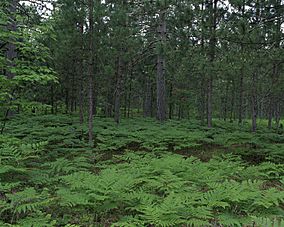Seney National Wildlife Refuge facts for kids
Quick facts for kids Seney National Wildlife Refuge |
|
|---|---|
|
IUCN Category IV (Habitat/Species Management Area)
|
|

Pinus resinosa forest, with Pteridium aquilinum understorey. Seney National Wildlife Refuge
|
|
| Location | Schoolcraft County, Michigan, United States |
| Nearest city | Seney, Michigan |
| Area | 95,264.66 acres (385.5224 km2) |
| Established | 1935 |
| Governing body | U.S. Fish and Wildlife Service |
| Website | Seney National Wildlife Refuge |
The Seney National Wildlife Refuge is a special place in Michigan where nature is protected. It's a huge wetland area, about 95,212 acres big, which is like 385 square kilometers! This refuge is in Schoolcraft County, near the town of Seney, Michigan. It's a safe home for many animals and plants.
Inside the refuge, you'll find the Seney Wilderness Area. This is a wild part of the refuge where nature is left untouched. There's also the Strangmoor Bog, which is a special natural landmark.
Contents
Animals and Wild Spaces
The Seney National Wildlife Refuge is a great home for many birds. But it's also where other cool animals live. You might see river otters, beavers, moose, black bears, and even wolves.
Over 211 different kinds of birds have been seen at Seney. These include ducks, majestic bald eagles, beautiful trumpeter swans, osprey, tall sandhill cranes, and diving common loons.
The Seney Wilderness Area
On the western side of the refuge, there's a special area called the Seney wilderness. This part is officially protected by law. It covers about 25,150 acres, which is like 102 square kilometers. Here, nature is allowed to grow and change without much human interference.
Strangmoor Bog: A Unique Wetland
The Seney Wilderness Area includes a very special spot called the Strangmoor Bog. This bog is a National Natural Landmark. It's considered one of the best examples of a "patterned bog" in the lower 48 states.
This type of bog formed after glaciers melted a long time ago. The melting ice left behind sandy plains. Wind and water then shaped the sand into parallel strips of higher ground and wet areas, creating a unique pattern.
History of the Refuge
The Seney National Wildlife Refuge was built on what used to be called the Great Manistique Swamp. This was a large wetland in the central part of Michigan's Upper Peninsula.
Long ago, from 1880 to 1910, the forests here were cut down a lot. Then, people tried to drain the swamp to make farmland. But this didn't work well. It left the wetland full of canals, ditches, and ponds that didn't drain properly. Many people then left their land because they couldn't pay taxes on it.
In the 1930s, during a time called the Great Depression, workers from the Civilian Conservation Corps (CCC) came to help. They rebuilt and improved the old drains and ponds. But this time, they did it to help manage the wetlands for nature. These ponds and drains are still used today by the people who manage the refuge. The Seney National Wildlife Refuge officially started in 1935.
Bringing Back the Canada Goose
When the Seney National Wildlife Refuge opened in 1935, the Canada goose was in trouble. Too much hunting had made their numbers very low. There were only a few wild geese left, and they tried to stay far away from people. One of the main goals of the new Seney Refuge was to create a safe place for these geese to live and grow.
In January 1936, the refuge brought in 300 Canada geese. These geese had their wings "pinioned," meaning they couldn't fly. They were given a fenced pond area and were fed. The hope was that these geese would have babies (goslings) that would learn to fly south for winter and then come back to the refuge.
The goslings were given special bands on their legs. This way, if they returned, the refuge staff would know. For many years, goslings were born and flew south, but very few came back. It seemed that illegal hunting was still happening where the geese spent their winters or along their migration paths. Also, the number of adult geese at the refuge dropped from 300 to just 45 by 1945.
Then, in March 1946, something amazing happened! Sixteen banded Canada geese returned to Seney. This small flock grew bigger each year. By 1956, the Seney Canada goose population had grown to 3,000 birds. It kept growing even after hunting was allowed again in the area. The project at Seney National Wildlife Refuge is seen as a huge success. It helped bring the Canada goose back as a common bird in North America's wetlands.
The Refuge Today
As of 2007, the U.S. Fish and Wildlife Service reported that about 88,000 people visit the Seney National Wildlife Refuge each year.
Seney NWR also helps manage other important wildlife refuges:
- The Huron Islands/Huron National Wildlife Refuge in Lake Superior.
- The Lake Michigan part of the Michigan Islands National Wildlife Refuge.
- The Whitefish Point Unit on Lake Superior. Here, the Whitefish Point Bird Observatory studies birds that are migrating. In 1998, the United States Coast Guard gave 33 acres from the Whitefish Point Light Station to the U.S. Fish and Wildlife Service. This land became part of the Whitefish Point Unit of Seney NWR.
The U.S. Fish and Wildlife Service works with the Michigan Audubon Society and the Great Lakes Shipwreck Historical Society to manage this area. They make sure the land is protected. In 2012, more land was added to the Whitefish Point unit. This included 19.85 acres and over 1000 feet of Lake Superior shoreline. This land is very important for the piping plover, a small shorebird that needs special habitat.



